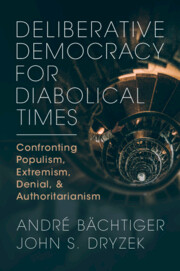 Deliberative Democracy for Diabolical Times
Deliberative Democracy for Diabolical Times Published online by Cambridge University Press: 28 March 2024
Denial means rejecting the best knowledge we have about the state of the world. In its extreme (but not rare) manifestations, denial means that no amount of evidence or argument can change that rejection. The main forms of denial dealt with here concern climate change, Holocaust, election results, and pandemic. Chapter 6 examines the sources of denial in both the psychology of identity and in the political economy, which involves powerful interests such as fossil fuel corporations organizing denial, before moving on to the range of communicative responses to denial. The discussion here begins with the more obvious (and likely ineffective) responses of presenting the facts and promoting objectivity. More promising deliberative approaches involve communication and rhetoric that might reach denial via discursive bridges, and sometimes even draw deniers into deliberative interactions. If that fails, denial might be diverted or kept out of places in deliberative systems where it can do the most damage.
To save this book to your Kindle, first ensure [email protected] is added to your Approved Personal Document E-mail List under your Personal Document Settings on the Manage Your Content and Devices page of your Amazon account. Then enter the ‘name’ part of your Kindle email address below. Find out more about saving to your Kindle.
Note you can select to save to either the @free.kindle.com or @kindle.com variations. ‘@free.kindle.com’ emails are free but can only be saved to your device when it is connected to wi-fi. ‘@kindle.com’ emails can be delivered even when you are not connected to wi-fi, but note that service fees apply.
Find out more about the Kindle Personal Document Service.
To save content items to your account, please confirm that you agree to abide by our usage policies. If this is the first time you use this feature, you will be asked to authorise Cambridge Core to connect with your account. Find out more about saving content to Dropbox.
To save content items to your account, please confirm that you agree to abide by our usage policies. If this is the first time you use this feature, you will be asked to authorise Cambridge Core to connect with your account. Find out more about saving content to Google Drive.